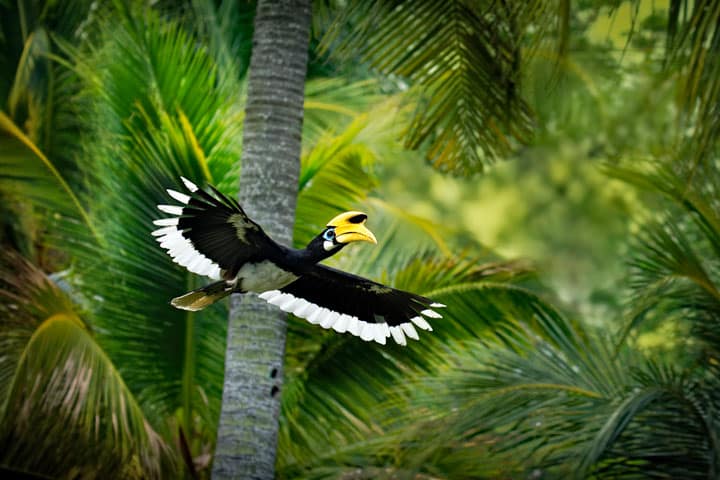The hornbill, a romantic love bird

They are striking birds and you can spot them in Thailand: The Hornbills (Bucerotidae). Projects have been set up to protect the birds in the Khao Yai National Park, Huai Kha Khaeng Wildlife Sanctuary and the Budo-Sungai Padi National Park in the Deep South.
The Thailand Hornbill Project is an example of a research and conservation program started in 1979 with the aim of stabilizing the hornbill population. There are approximately 3.500 specimens of these captivating birds in Thailand.
A distinctive feature of all hornbills is the curved bill, much like that of the unrelated toucans. This beak is brightly colored in many species. Except in the species of the genus Tockus, there is a curled "horn" on top of the beak. This part of the beak is usually hollow and consists of loose bone tissue. Only the helmeted hornbill (Rhinoplax vigil) has a solid bone horn.
Hornbills are relatively large, slender-built birds with a long neck and short, broad wings, and often a long tail consisting of ten tail feathers. Certain parts of the head and neck consist of naked skin with striking colors.
All hornbills nest in tree cavities. The female is “walled in” until a small hole remains. As a result, she and her offspring are protected against predators. The male is responsible for the food supply until the young fledge.
The hornbill forms a biological index of forest health. Each bird needs 500 to 600 square kilometers to fly and live. Conservation of the birds stimulates the realization that it is important to protect large areas of forest - not only trees, but also connections between forests. Birds have an important job because they spread seeds so that they can germinate elsewhere in the forest. Food sources are thereby expanded and a balance is created in the ecosystem.
The Hornbill's personality is often described as 'captivating and very romantic'. The birds are love birds and naturally monogamous. When the female isolates herself, the male takes care of her, forages for food and feeds her. The bird can thus be regarded as a symbol of love and self-sacrifice.



I saw them on koh Samet last week. Every morning a group of five came to sit in the same tree. After ten minutes they flew on again. Fascinating to see.
I have been living on Koh-Samet for more than 20 years and regularly spot them, not only in the woods but even
occasionally in the trees in the center of the village.
It is written here that they need 500 to 600 km2, but Koh-Samet is not that big.
And they can't make that distance between Koh Samet and the mainland, which would be about 5 km as the crow flies?
Insofar as they would need it at all, because they can probably find everything on the island.
I spotted them last year on Koh Phayam, great beautiful bird
I already saw these hornbills in a small farming village in the Netherlands in the 80s. During the winter, the birds had to be kept in a tropical cage that was heated to around 27 degrees.